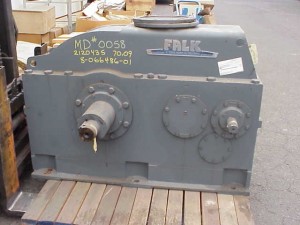 In the world of power transmission products, lube oil is one of the most important factors in extending the life of Falk gears and gear drives.
In the world of power transmission products, lube oil is one of the most important factors in extending the life of Falk gears and gear drives.
Lubricants help prevent the metal components within a gear drive from having contact with one another, thereby reducing the amount of friction within the machinery. Lube oil also helps avert prevent premature wear by reducing the amount of contaminates and particles within a gear drive.
The type, quality and cleanliness of the lube oil can make the difference between getting the most out of a Falk gear drive versus cutting its life short.
Choosing the Right Type of Lubrication
The best lubrication for a gear drive is the kind recommended by the manufacturer on the plate of the drive, which is designed to help balance the needs of the bearings and the gears. Gears typically need a heavier type of lube, while bearings require a lighter formula.
The right balance of lube within a gearbox has the proper viscosity, which determines the strength and thickness of the lubricant’s film. Consequently, the viscosity of the lubricant affects the life and performance of the gear drive. Factors that affect the viscosity of lube oil include drive loads, ambient temperature, the final operating temperature of the Falk gear drive and the operating speed.
Lube Types
An individual should always consider the viscosity range when choosing a lube oil. Lube types include those that are R&O (rust and oxidation) inhibited mineral oils, as well as synthetic oils and extreme pressure compounds.
Most gear drive manufacturers recommend using the American Gear Manufacturers Association’s (AGMA) 250.01 Lubrication of Industrial Enclosed Gear Drives as a standard. Advice provided by the AGMA includes the use of lighter oils when operating a gear drive in cold weather because they circulate better at in lower temperatures. On the other hand, the AGMA also recommends using lube oil that has a higher viscosity because it will hold its strength, thickness and film strength.
Enclosed gear drives use four basic kinds of lubricants:
Single-grade R&O lube. This type of lube is one of the most highly recommended by manufacturers because of its lower price, reputation for good performance and resistance to breaking down from the additives that cause oxidization. Single grade R&O lube does not have a wide ambient temperature range, which can result in seasonal changes to make sure the viscosity matches the anticipated temperature changes.
Multi-grade R&O lube. This type of lubricant offers itself to a wide range of temperatures. However, it also has a limited life and is not recommended for gears that are in the mid- to high-horsepower range.
Extreme pressure lube. This lube type helps provide more protection from friction and metal-to-metal contact. As a result, the protection provided increases the life of the gear in heavily loaded or marginal synthetic hydrocarbons. Extreme pressure lube costs more than other types of lubricants but provide a wider span of operating temperatures. This wider range can possibly help eliminate the need to change the lubricant in a gear drive on a seasonal basis.
While this lube increases the operating efficiency of a Falk gear drive and reduces friction levels, synthetic lubricants are more susceptible to contamination. Extreme pressure lubes may be compatible with R&O mineral oils, but it is always best to flush the gear drive at least once if changing to synthetic lubricants.
Maintaining Lubricants
After purchasing a lubricant, maintaining it is just as important as maintaining the Falk gear drive itself. Just like a gear drive’s components, lubricants wear out, and their qualities change with age and temperature.
An individual can prevent a lubricant from causing metal-to-metal contact and sludging by changing the lubricant regularly or by sampling the lubricant used in the gear drive with an oil-and-ferrographic analysis at a lube supplier or independent laboratory. It is also recommended that individuals look for differences in the original viscosity of the lube within the gear drive, as well as for water content, foreign particles, internal contamination and wear particles over time. It is always important to follow the lubricant and gear drive manufacturers’ instructions and guidelines for best results.
Proper lubrication is the number one way to get the most life from a Falk gear drive. By choosing the correct lubricant and maintaining it so it stays in good condition, a gear drive is more likely to remain problem-free.
Posted under Machinery Maintenance on Tuesday, March 22nd, 2011
